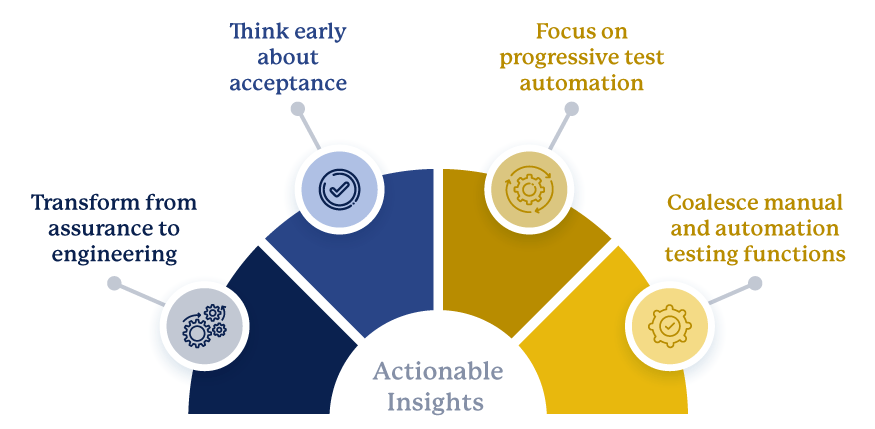

Client
A leading multi-level marketing company
Goal
Shorten the release cycle and improve product quality
Tools and Technologies
Amazon CloudWatch, Elasticsearch, Bitbucket, Jenkins, Amazon ECR, Docker, and Kubernetes
Business Challenge
The client's Commercial-off-the-shelf (COTS) applications were built using substandard code branching methods, causing product quality issues. The absence of a release process and a manual integration and deployment process were elongating release cycles. Manual configuration and setup of these applications were also leading to extended downtime. Missing functional, smoke, and regression test cases were adding to the unstable development environment. The database migration process was manual, resulting in delays, data quality issues, and higher costs.

Solution
- Code branching and integration strategy for defects / hotfixes in major and minor releases
- Single-click application deployment, including environment creation, approval and deployment activities
- Global DevOps platform implementation with a launch pad for applications to onboard other countries
- Automated configuration and deployment of COTS applications and databases
- Automation suite with 90% coverage of smoke and regression test cases
- Static and dynamic analysis implementations to ensure code quality and address configuration issues

Outcomes
Automation of release cycles delivered the following benefits to the client:
- Release cycle shortened from once a month to once per week
- MTTR reduced by 6 hrs
- Downtime decreased to <4 hours from 8 hours
- Product quality and defect leakage improved by 75%
- Testing time reduced by 80%
- Reach expanded to global geographies
- Availability, scalability, and fault tolerance enhanced for microservices-based applications

Our experts can help you find the right solutions to meet your needs.
DevOps solution improves scalability by 5x



Client
North America-based fertility and genomics company
Goal
Expand business reach, reduce time-to-market, and support critical compliance
Tools and Technologies
.NET 5, Vue.js, AWS Secrets Manager, AWS Transfer Family, Amazon RDS, Amazon EKS, Amazon Route 53, Amazon CloudFront, Terraform, GitLab
Business Challenge
The client wanted to expand its reach to Canada, Europe, and APAC regions to meet the requirements for a 10x increase in their user base. Legacy application infrastructure and code built on the old tech stack, with high technical debt, were slowing down the rollout of new features, making the client less competitive. The infra-deployment process was only partially automated, stretching the time-to-market to three months. The total cost of ownership was relatively high. HIPPA and PII compliance were also not supported.

Solution
Iris modernized the application into microservices, built the infrastructure using Terraform and automated its provisioning and configuration.
- Application developed using .NET 5 and Vue.js
- Architecture transformed into cloud-native
- AWS Managed Services, including Secrets Manager, AWS Transfer Family, RDS, EKS, Route 53, CloudFront, and S3, configured using Terraform
- EKS Cluster and associated components provisioned via Terraform
- App pushed to container registry using GitLab pipeline
- Secrets (API keys, database connection strings, etc.) and app images moved to EKS Cluster using S3 Bucket Helm
- Static code analysis, coverage and vulnerability scans integrated to ensure code quality and reduce configuration issues

Outcomes
Our DevOps solution enabled the client to achieve significant benefits, including:
- Application launch in Canada and Europe; Asia Pacific release in the pipeline
- HIPPA and PII compliance
- 5x scalability improvement from weekly average usage
- Time-to-market reduced from three months to 3 weeks
- Total cost of ownership lowered by 50%

Our experts can help you find the right solutions to meet your needs.
Order management platform transformation



Client
Multinational publishing, media, and educational company
Goal
Improve order management and transaction processing capabilities
Technology Tools
AWS EKS, Kong, Salesforce Commerce Cloud (SFCC), Salesforce CRM, Jenkins, Sumo Logic, Datadog
Business Challenge
The client's order management platform was complex and had scalability issues, causing poor customer experience and loss of revenue. The platform was hosted on Oracle cloud, with data stored in different repositories. Services were also hosted in the Oracle cloud, which used the BICC extract to fetch information about order details from Oracle databases. The low performance of customer-facing applications was causing latency and very high transaction processing time.

Solution
Team Iris transformed Oracle-based SOA services into six microservices and migrated them to AWS EKS for autoscaling with self-healing and monitoring capabilities.
We developed services for publishing data to Salesforce CRM for quick order processing and conversions. The BICC system for diversified information and order history was enabled with real-time integration between Oracle Fusion and materialized views for data consumption.
Post migration, these services were registered in Kong for discovery, and a CI/CD pipeline was created for deployment using Jenkins. Sumo Logic was used for monitoring the logs, and Datadog was used to observe latency, anomalies and other metrics.

Outcomes
The order management platform transformation delivered the following benefits to the client:
- System performance improved by 70%
- Transaction processing capability increased by 4x
- Order processing capabilities were enhanced by 200%
- Total cost of ownership (TCO) was reduced by 30%

Our experts can help you find the right solutions to meet your needs.
Next-gen platform reliability engineering for Blockchain-DLT


Banking & Financial Services
Next-gen platform reliability engineering for Blockchain-DLT

Client
A leading digital financial services company
Goal
Blockchain- DLT platform assurance with improved automation coverage
Tools and Technologies
Amazon Elastic Kubernetes Service (EKS), Azure Kubernetes Services (AKS), Docker, Terraform, Helm Charts, Microservices, Kotlin, Xray
Business Challenge
The client's legacy DLT platform did not support cloud capabilities with the Blockchain-DLT tech stack. The non-GUI (Graphic User Interface) and CLI (Command Line Interface)-based platform lacked the microservices architecture and cluster resilience.
The REST (Representational State Transfer) APIs-based platform did not support platform assurance validation at the backend. Automation coverage for legacy and newer versions of the products was very low. Support for delivery patches was insufficient, impacting the delivery of multiple versions of R3 products each month.

Solution
Iris developed multiple CorDapps to support automation around DLT-platform functionalities and enhanced the CLI-based & cluster utilities in the existing R3 automation framework.
The team implemented the test case management tool Xray to improve test automation coverage for legacy and newer versions of the Corda platform, enabling smooth and frequent patch deliveries every month.
The quality engineering process was streamlined for the team's Kanban board by modifying the workflows. Iris also introduced the ability to execute a testing suite that could run on a daily or as-needed basis for AKS, EKS, and Local MAC/ Windows/ Linux cluster environments.

Outcomes
The Blockchain-DLT reliability assurance solution enabled the client to attain:
- Improved automation coverage of the DLT platform with 900 test cases with a pass rate of 96% in daily runs
- Compatibility across AWS-EKS, Azure-AKS, Mac, Windows, Linux, and local clusters
- Increased efficiency in deliverables with an annual $35K savings in the test case management area

Our experts can help you find the right solutions to meet your needs.
Tech stack automation expedites development by 3x



Client
A leading building supplies manufacturing company
Goal
To support 30+ applications stack for UI, E2E, APIs, performance, mobile automation along with DevOps pipeline integration
Tools and Technologies
.NET Core, PeopleSoft, Salesforce, WMS, JavaScript, Angular, Foxpro, C#, Selenium, SpecFlow, RestSharp, Nunit, Mobile Center/Emulators, Allure, Jira, Azure Pipeline, GitHub
Business Challenge
The client had technology stacks comprising of diverse technologies that were difficult to manage. Substantial manual effort and time were spent on integrating the checkpoints, elongating the development process. Validating end-to-end business flows across different applications was the prime challenge. Reporting processes were also scattered across the entire application stack, making it vulnerable.

Solution
Iris developed a robust application agnostic Test Automation framework to support the client’s multiple-technology stacks. Following the Behavior-driven Development (BDD) approach to align the acceptance criteria with the stakeholders, we built business and application layers of the common utilities in the core framework.
Our experts identified E2E business flows to validate the downstream impact of the change and automated the entire stack through the shift-left approach. Azure DevOps integration enabled a common dashboard for reporting. The client attained complete version control to track production health and enforce strong validations.

Outcomes
Iris Automation solution enabled the client to surpass several business goals. The key outcomes of the delivered solution included:
- ~65% Increase in automation coverage
- 100+ Pipelines for in-scope applications across multiple environments
- 3700+ Test Automation scripts execution per sprint cycle achieved across applications
- 3X Faster script development of behavior-driven test cases
- Multi-day manual test effort reduced to a few hours of automated regression
- 70% Reduction in effort

Our experts can help you find the right solutions to meet your needs.
Digital ledger secures trading integrity



Client
Global bank's trading operations
Goal
Resolve trading transaction breaks and related regulatory issues through expandable intra-company digital ledger system
Tools and Technologies
Hyperledger Fabric 1.4/2.2, Java 8, Go Language 1.8, Kafka, Node JS, Microservices, OpenShift, Dockers, Kubernetes
Business Challenge
A highly-manual, paper-dependent, trading and reconciliation process was causing the accumulation of a large number of daily transaction liquidity breaks, which had been cited by federal regulators and risked a billion dollar cost impact.
The lack of a robust trade audit and reconciliation process to reduce liquidity breaks and operating costs led the bank to seek an immutable system that could record and unify financial practices and be expanded to other transaction areas.

Solution
Iris solution comprised a production-ready, configurable platform using microservices and blockchain-based digital ledger architecture. It employed Smart Contracts coded with requisite business rules to facilitate front office trade booking and trade reconciliation processes.
RPA was utilized to automate data mapping and testing of transactions. Preventive controls were enabled by recording intra-company transactions at their initiation using uniform booking practices, and consequently guaranteeing the term of the trade. A multi-layered infrastructure was created to support real-time, batch streaming of differing file formats. The UX was enriched through Interactive UI and automated workflows.

Outcomes
Iris successfully introduced a global intra-company distributed ledger and trade reconciliation system that did not exist before. With self-executing contracts matching both sides of transactions prior to feeding downstream systems, the platform ensures complete integrity at the source and reduces time and cost for all transactions. The solution also achieved:
- 30% fewer liquidity breaks
- 70% improvement in operational efficiency due to the use of RPA
- 60% reduction in business-rules configuration time, due to the smart contracts

Our experts can help you find the right solutions to meet your needs.
Software transformation gets compliance for bank


Risk & Compliance
Software transformation gets FDIC compliance for bank

Client
A global investment bank
Goal
To have a unified functional validation system for FDIC compliance
Tools and Technologies
SQL Server, Sybase, Data Lake, UTM, .NET, DTA, Control-M, ALM, JIRA, Git, RLM, Nexus, Unix, WinSCP, Putty, Python, PyCharm, Confluence, Rabacus, SNS, and Datawatch
Business Challenge
The client mandated to comply with new QFC (Qualified Financial Contracts) regulations. The client also needed to perform in-depth functional validation across a revamped data platform to ensure it could timely process, review and submit to the FDIC (Federal Deposit Insurance Corp.) required daily reports on the open QFC positions of all its counterparties.
The project entailed immediate availability and processing of accurate QFC information at the close of each business day to swiftly assess data and note exceptions and exclusions for early corrective action. It also aimed to help the client meet stringent deadlines with varied report formats. Any breach or delay in compliance could attach hefty fines and reputational damage to the bank.

Solution
Iris revamped the entire system and performed end-to-end quality assurance and testing across the new regulatory reporting platform. This meant validating the transformed multi-layer database, user interface (UI), business process rules, and downstream applications.
We identified and solved workflow design gaps affecting data reporting on all open positions, agreements, margins, collaterals, and corporate entities, thus enhancing the capability for addressing irregularities. Our experts established an integrated and collaborative system, commanding transaction and reference data within a single platform by incorporating 166 distinct controls pertaining to data completeness, accuracy, consistency, and timeliness within a strategic framework.

Outcomes
Our quality assurance and testing solution delivered the following impacts:
- Faster and more efficient internal analysis with highly accurate QFC open positions
- 100% compliance with timing and format of required daily QFC report submissions to the FDIC
- Significant decrease in exceptions before the platform went go-live and critical defect delivery drastically reduced post-implementation
- An intuitive UI dashboard reflecting the real-time status of critical underlying data volumes, leakages, job run, and other stats

Our experts can help you find the right solutions to meet your needs.
IT modernization boosts Insurance customer base



Client
A leading American Fortune 500 Insurance Services Provider, offering insurance, investment management and financial products & services across the Americas and 40 other countries
Goal
To advance business agility and customer experience through modernized business systems
Tools and Technologies
C#/.NET, JAVA, DevOps, Python, NodeJS, App Services, Managed Application Support
Business Challenge
The client’s existing business applications, systems, and support services were in stasis and not delivering the much-needed value to the insurer and end customers.
Due to the lack of enterprise application portfolio strategy, business functions were onboarding applications in a silo. The net impact was that the insurer’s revenue and market share decreased.
Longer turnaround times and outdated UI were discouraging customers. On the other hand, prospective customers were also opting for modernized options available in the market.

Solution
Iris delivered app development and managed services across Annuities, Life Insurance, Group Insurance, Retirements and the Global Enterprise Service groups that decide the platform for all business units. Our services spanned around Enterprise Collaboration portal, Financial Wellness platform, Mutual Fund platform modernization, Oracle EBS development and support, and Retirement Annuities platform management.
We also executed a scaled Agile program and ran multiple Scrums within the enterprise development and support landscape. Iris tech experts established DevOps and scaled Agile Framework within the client organization and enabled a team of over 150 professionals globally to support business operations 24X7.

Outcomes
Iris has been working around the application portfolio for over three years. We have helped the client deliver an exceptional experience to employees and end customers through active service support. Key outcomes of the delivered solution included:
- Infrastructure availability increased to 99%
- Optimized maintainability reduced the KYC process time by 75%
- Customer response time cut down by around 40%
- Promoter score incremented from 5 to 9 out of 10
- Customer retention improved by nearly 80%
- Customer acquisition increased by 65%

Our experts can help you find the right solutions to meet your needs.
Home » Services » Automation » Page 4

Accelerate your agile software development
Businesses are increasingly using cloud technologies and service-oriented architectures to deliver their products and services on digital channels. They also want those IT solutions delivered increasingly faster. In order to meet those demands, IT has adopted Agile methodology to reduce time to develop new capabilities, apply fixes and deploy them to production.

The nature of software development is transforming with more frequent releases and monolithic architecture giving way to services. Consequently, there is a greater need to ensure that overall quality does not degrade in terms of usability, reliability, scalability and performance. Clearly, as application architecture is being modernized and software is being deployed expeditiously, this method of testing will not empower IT to deliver effectively. Practical experience has given us some actionable insights to shift approaches to quality in an Agile development environment.
Challenges
We find organizations frequently face the following key challenges in transforming their approach to Quality Engineering in an increasingly Agile enterprise:

Iris Solution
Iris solution combines using Acceptance Test Driven Development (ATDD) methodology to bring in the culture of early acceptance with continuous testing from development to production. This approach leverages DevOps and incorporates In-sprint Test Automation to accelerate between transition from a QA to a QE mindset. Our solution has a framework that enables these features:- Integration with tools that allow for developing a common understanding of requirements and specifications within the team
- Configuring a customer’s Agile development process (e.g., “Done” criteria) by integration with industry-standard tools that support code development, test scripts development and auto triggering of test execution, deployment and continuous monitoring
- Libraries with templates for gathering requirements and pre-built code for test execution, deployment and reporting
- A storehouse of reusable libraries that allow for quick access and updates of test scripts and easy integration of new components, thus reducing the maintenance burden
- A cross-referenced checklist to mark completion of all user stories, which is one of the most critical checkpoints in an Agile project
- A machine learning layer with baseline objects to support features such as self-healing and test analytics reporting. Using this facility, an Agile project can support automatic fixing of test scripts and test execution predictability, thus reducing the time and cost of custom development
Iris Automation Practice: Focus Areas and Competencies
Iris Automation Practice offers comprehensive services and solutions across competencies such as Intelligent Automation, Test Automation and DevOps Automation. Our approach introduces automation within the context of a function or industry to create seamless end-to-end processes and experiences. Our services, strengthened with machine learning and cognitive technologies, have stepped up productivity, resulting in immense benefits for our clients.Business Outcomes
- Our ATDD framework reduces the effort of building test automation suites by 30% and cuts maintenance costs by up to 60%
- Faster delivery cycles improve collaboration, thereby reducing total cycle time by 25%
- Reusability and modularity reduce efforts by up to 25%
- Increased coverage in regression test suite by 30-40%
Contact
Our experts can help you find the right solutions to meet your needs.
Get in touchCloud transformation increases business agility



Client
A non-profit global organization responsible for developing and maintaining standards, including barcodes with over 115 local member organizations and over 2 million user companies
Goals
To deliver MVPs in shorter cycles, reduce Mean Time for Ticket Resolution (MTTR), and lower the total cost of ownership
Tools and Technologies
C#/.NET Core, Python/DJango, NodeJS/Express, Azure WAF, Azure APIM, App Services, Azure Kubernetes Service, Azure Monitor, and Application Insights
Business Challenge
The client had a suite of legacy applications to generate barcodes that are scanned globally over 6 million times a day.
These applications were built on monolithic architectures using heavy-weight application servers and outdated technologies. This architecture was causing long development cycles, making the organization less competitive. Developers’ productivity was also dropping due to high technical debt.

Solution
Azure cloud offered some of the foundational features like container orchestration, app engine, integration, API gateway, monitoring and others, making cloud-specific modernization a natural choice.
Modernization strategy involved reverse engineering of on-premise applications, domain-specific grouping the product backlogs by, adopting domain-driven design, and using open source cloud-friendly software with CI/CD pipeline. We transformed the applications to a .NET core framework using cloud-native design principles on Azure cloud. The solution was developed using Azure App Services, front door and service bus following the agile development approach with two-week sprints.

Outcomes
- Reduction in Mean Time for Ticket Resolution (MTTR) by 30%
- Increase in application and infrastructure uptime to 99.9%
- Real-time visibility of application and infra metrics
- Enabled bi-weekly MVP delivery

Our experts can help you find the right solutions to meet your needs.
Industries
Company

Bring the future into focus.
